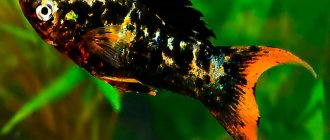Mollies are not a very large group of viviparous ornamental aquarium fish. Aquarists love them for their peaceful disposition, unpretentiousness and variety of colors.
They are characterized by high mobility, so it is better to select an aquarium of 50 liters or more to keep them.
When asked how long mollies live, experienced aquarists will confidently answer: it all depends on the favorable environment, but the average life expectancy is 4 years.
Popular types
Natural species of mollies (there are only 4):
- Poecilia sphenops - sphenops, or small-finned mollies;
- Poecilia salvatoris - free mollies;
- Poecilia velifera - Velifera molly;
- Poecilia latipinna - Latipin molly.
Through the efforts of aquarium breeders, popular hybrids have been developed that can be found in aquariums around the world.
Sphenops
The most popular color of sphenops is black, but other types are also found (white, speckled, yellow). It is almost impossible to find natural gray colors in a decorative aquarium.
The body shape of sphenops is elongated, slightly compressed on the sides, the body of the fish is dense.
Females are larger than males and can reach up to 10 cm in length; males rarely exceed the 6 cm limit.
The fins are small, but the fish are very jumping, and if there is no lid on the aquarium, they can easily jump out and die ingloriously in their prime.
Lyrebird
A distinctive feature of this molly is its unique tail fin. The fish got its name for its resemblance to a lyre.
There is no differentiation by color, since many morphs with this trait have been bred; they can be found not only among sphenopsids, but also among other varieties of mollies.
Two-color
The two-color variety is considered a very valuable specimen among connoisseurs of ornamental aquarium fish.
The front of the body may be golden or orange, while the tail and anal fin are black.
Attention! Fish with a matte black color are highly prized.
Black mollies
This is the most common species of mollies. Color options can vary from matte black to olive brown or black with blue (green) tint to the scales.
Interesting! Black mollys can “regenerate”, that is, change their gender; this property is not lost with age.
Silver spotted molly (Dalmatian)
This molly is not very large, does not exceed 6 cm in length, has a beautiful light color with a silver tint and small black spots, like Dalmatians, which is why it got its name.
It may have some morphological changes in the structure of its fins and their size, but they are usually insignificant.
Mollies balloon
A selection form of the broad-finned variety of molly. Its body resembles an inflated balloon: the ridge is curved and protrudes upward, and the abdomen protrudes strongly downward; it is much shorter than that of other representatives of the genus.
In this regard, dysfunction of internal organs may occur.
Important! These aquarium inhabitants have a tendency to become obese.
Sail molly
The fish got its name for its elegant dorsal fin; in some individuals it can reach the height of the body - such specimens are considered the most valuable breeding representatives.
Males are usually brighter than females and have a more pronounced fin. There are many varieties of color, and there are spotted representatives.
Red leopard
They are distinguished by their red-orange or red color. Sometimes there are individuals with black spots, thanks to which this species of molly received the name “red leopard”. Under favorable living conditions it can reach a size of 12 cm.
Petena mollies
The variety got its name from the place where it was discovered - Lake Petén in Guatemala. It has a pearlescent tint on the scales, a xiphoid process on the caudal fin, and a color without spots.
Sometimes there is a bright red stripe on the fins. These characteristics distinguish molly peten from others.
Marble or chintz
Marbled mollies are highly valued among aquarium hobbyists. It is considered an elite variety and is distinguished by its beautiful marbled color.
High fin green and orange
Large, can reach 12 cm in length. They are distinguished by a high-positioned dorsal fin; The caudal fin is small and round in shape.
Silver mollies
The medium-sized fish with high dorsal fins are distinguished by their noble silver color. Very peaceful. They require increased attention because they are prone to overeating.
Mollies Velifera
Large (up to 15 cm) wide-finned molly with a variety of color options. The fins are set high.
They are distinguished from other varieties by their life expectancy - it can reach 5 years or more.
Snowflakes molly
A very popular variety of mollies with snow-white scales and fins. The tips of the plumage may turn blue.
Large individual specimens reach a size of 14 cm. You should monitor the diet of these beauties: they eat too much.
Freestyle
Rare guests in aquariums: these are representatives of natural fish, and not bred through selective selection. They were found in waters of Guatemala.
They are very unusual due to their multi-colored fins, which can be black, red or white.
Latipinny
Hybrid representatives are more common in aquariums. During selection, this fish has lost its resemblance to its relatives in the wild.
It is noticeably larger than its relatives (males can reach 15 cm, females - 18). They are distinguished by a large rectangular dorsal fin. Coloring can be very diverse.
Dwarf
These are the smallest mollies: males rarely grow more than 3 cm, females - 4 cm. They feel best in an aquarium in schools with a predominance of females.
Yellow
Mollies are medium in size and have a uniform body color of various yellow shades. The most valuable are pale lemon colors. There are dark spots on the plumage.
Golden mollies
A subspecies of sphenops with a lemon-black or golden-yellow color. The scales shine brightly, it seems that the fish shimmers with shades of yellow.
Small-finned molly
They are distinguished by their silvery ventral color and almost transparent fins.
The color can be any. The fish are small in size and have small fins, which determined the name of the species.
Coffee
A variety of velifer with an original color that resembles the color of roasted coffee beans. There may be dark brown markings on the fins.
Orange
Beautiful medium-sized fish with amazing bright orange scales. To maintain the brightness of the color, it is recommended to add food rich in carotene to the fish’s diet.
Albino molly
A variety of albino mollies bred by Thai breeders. It is distinguished by large fins - they can even exceed the size of the plumage of sailfish. They often have a lyre-shaped tail.
Interesting! In adults, yellowish spots may appear on the body.
History of aquarium breeding
Mollies appeared in the aquarium hobby at the turn of the 19th and 20th centuries, and as a result of 20 years of breeding work, the first hybrid specimens were developed.
Now there are a lot of varieties of mollies, but only a few of them, for example, Velifera, are especially popular. A strange confusion arose with this breed; ichthyologists classified it as two species at once - Mollienesia and Poecilia, which is why it is sometimes called platie.
Mollies were discovered for the first time in America; later this species was introduced and distributed in the reservoirs of Colombia, Israel, Japan, Taiwan and Eastern Europe.
Content
Mollies are incredibly easy to keep and are suitable even for beginners in the aquarium business.
Aquarium volume
Since the fish are active and playful, it is better to choose an aquarium with a volume of at least 30 liters for their habitat . The calculation is as follows: per individual there should be at least 6 liters of water.
Mollies are thermophilic; the optimal water temperature in the aquarium is 23 °C . Constant aeration is required, so a compressor will be needed.
View this post on Instagram
Publication from Tatyana (@tat.cotunova2011) November 30, 2021 at 12:36 PST
Feeding Mollies
Mollies are gluttons, they eat greedily and a lot. The main problem with fish is overeating. Therefore, you should follow the feeding recommendations:
- Dry food is diluted with hamarus , bloodworms or finely chopped earthworms at least once a week.
- The diet should contain plant elements. Finely chopped lettuce or seaweed .
- You can plant moss riccia - this will become an excellent food additive.
- Occasionally, the standard diet is supplemented with steamed semolina, oatmeal, and boiled beef .
- Once every one and a half to two weeks, give the fish a fasting day .
Feeding Mollies
Mollies are omnivores; their diet should include a sufficient amount of plant food. Feeding any fish should be correct and varied, this is the key to good health. Mollies are very voracious, so it is important not to overfeed them to avoid digestive problems.
You can easily use TetraMin as a base feed. And colorful colored morphs with yellow and red tones can be additionally fed with food containing carotenoids - from the color series.
Allow me to make a small note. Color series food (contains “color” in the name, for example, TetraPRO Color Multi-Crisps) - enhances the natural color of fish (only!!! - red, yellow colors), since it is enriched with pigments such as canthaxanthin, astaxanthin . In fact, carotenoids are natural “coloring” substances. It is astaxanthin that gives plants their red-orange color, carrots are a prime example of this. Or, for example, have you ever wondered why flamingos are pink? Yes, that's exactly why. By eating plant and animal foods rich in carotenoids, the flamingo's plumage, which is initially white, gradually turns pink. The more birds receive this substance from food, the richer and redder the plumage becomes. If you look even deeper, flamingos eat the well-known brine shrimp - pink, saltwater crustaceans and also turn pink.
Actually, the same thing happens to fish if the food contains carotenoids. We also note that astaxanthin also has other beneficial properties - it is also an antioxidant. In general, we can say that carotenoids are beneficial not only for fish, but also for all aquatic organisms, even aquarium plants. The only thing is that everything should be in moderation and balanced. You need to understand that the color of the fish also depends on the state of health, environment, life circumstances (stress/spawning) and the characteristics of the aquarium lighting.
Actually, to summarize, the Color series food is good, but should not be a basic diet. Imagine what will happen to a person who eats only one beet all week =) It’s scary to imagine. The same goes for the fish... sorry, they start pooping cute pink poop.
In this matter, by the way, it is very important not to overfeed the fish, so as not to run into problems with the gastrointestinal tract. Feed molly once a day, do fasting days. This will be one of the keys to success in their maintenance. It should be noted that when purchasing any dry food, you should pay attention to the date of its manufacture and shelf life, try not to buy food in bulk, and also store the food in a closed state - this will help to avoid the development of pathogenic flora in it.
Reproduction
Mollies are viviparous fish. The process of obtaining offspring is not too complicated, but it requires some attention.
Females are larger than males and reach sexual maturity a little earlier - by 6 months. Males are able to fertilize a clutch at the age of 9 months .
Usually the couple is separated from the main group into a separate aquarium, where mating occurs. At one time, the male fertilizes the entire clutch in the female’s stomach.
The average duration of gestation is about 45 days . The diet of a pregnant female should include vitamin supplements and protein.
After giving birth, the mother must be immediately separated from the fry - they are able to feed on their own.
Description and habitat
Mollies are a heat-loving, viviparous fish of the Poeciliidae family of the ray-finned class with a lifespan of about 4 years. Its closest relative is the guppy.
The average size of aquarium specimens is about 6 cm, and in nature, males reach a length of 10 cm, females even 16 cm.
Wild varieties are gray-yellow in color with a silvery tint, with the back always darker than the belly. These are very peaceful, but unusually active underwater inhabitants.
There are three main types of mollies common in natural habitats:
- small-finned;
- broad-finned;
- sailing
Breeders have currently bred about 30 new breeds.
The native species are the Central and southern parts of North America; the sphenopis variety is also found in the reservoirs of Mexico and Colombia.
Today, after the spread of this species of fish throughout almost the entire globe, varieties of free and peten mollies live in the reservoirs of Guatemala and the eastern part of the United States of America. And sailing and velifer ones are on the island of Yucotan.
Photo gallery of mollies:
This fish prefers fresh water bodies, but can also live in slightly salty bays or on sea coasts, for example, in the lowlands of rivers flowing into the Atlantic Ocean. And the Latipinna species also lives in slightly saline lakes in the states of Virginia, Florida, Carolina, and Texas.
These fish settle in river mouths, lakes, ditches, and reservoirs of karst caves. They are usually omnivorous, although some species prefer worms and insects, while others feed almost exclusively on algae, such as latypal.
Compatibility
Black mollies get along with a variety of neighbors. Large predators, catfish, are contraindicated. The skin of goldfish is covered with mucus, which the mollies eat along with their scales and fins. Males conflict with tiger barbs.
Keeping with other platies is not recommended. Due to cross insemination.
They live harmoniously with all viviparous animals.
Fish diseases
In most cases, diseases of mollies, like all viviparous fish, are caused by improper care. To prevent this from happening, they need to be carefully looked after.
Black molly
Causes of the disease:
- Bad content.
- Overfeeding.
- Infections.
- Colds.
- Poor quality water change.
- Improper transportation of fish.
The main signs of the disease in fish:
- Small bubbles form on the body or a fluffy area on the scales is detected.
- Dark spots, swelling or traces of white spots are visible on the fins.
- Bug-eyed fish is an infectious disease. The cause may be infection or poor care.
Based on these signs, a primary diagnosis can be made. “Goggle eyes” is more of a symptom than a disease.
Types of fish diseases:
- Melanosis (the color of the fish changes). The pigment becomes more pronounced, degenerating into a tumor.
- Ichthyophthirius (in owners of mollies, the fish was covered with white spots, similar to semolina).
- Bacterial diseases (damage to one or another type of bacterium):
- Fungal diseases (caused by fungi): these are moss, cotton wool, fluff on the body of the fish. If the fin turns white and is covered with semolina, then the diagnosis is obvious.
- Flagellates and ciliates - spots, rashes, holes.
- The mollies swim upside down or have changed the angle of movement. The cause may be a stone or foreign body.
- One or both eyes are bulging. Visually the eye comes out of its socket. Protrusions are observed very pronounced with clouding of the eyes. This indicates exophthalmos. The fish may lose sight and die.
Reviews
Aquarists value the black molly for its appearance and livability. Ability to produce offspring in a community aquarium. Does not require separate food.
Dissatisfied with eating plants. I'm not happy with the appearance: it's gloomy. Cases of unexpected aggression have been recorded.
Introduction
One of the most popular aquarium fish are mollies.
They began to be grown in aquarium conditions in 1899, and over the next 20 years many hybrids appeared. The name of these fish in Latin is Mollienesia. This is the old name of the genus of these fish; they are currently classified in the genus Poecilia.
— Advertising —
Mollies in nature are inhabitants of fresh and brackish waters of Central America. The sailfin molly came to us from the Yucatan Peninsula, and the broad-finned molly came to us from North American reservoirs with weak currents.
There are many variations in the coloring of mollies - the fish can be either plain or spotted. In appearance, these fish resemble swordtails, but differ from them in the shape of their fins: the tail fins of mollies are wider and the fins on the back are noticeably larger than those of swordtails. In an aquarium, mollies grow up to 6-8 cm, wild representatives of the genus are 1.5 times longer. Mollies live for about 4 years, and with good care they can live up to 8 years.











